Learn exactly how and when to expect the next display of the northern lights with a few easy-to-use online tools.
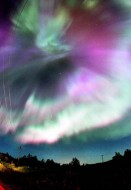
Bob King
I'm often asked when is the best time to see the northern lights. I usually point out that they're connected to solar flares and vast eruptions of solar plasma called coronal mass ejections or CMEs. While these violent events and the auroras they spawn are more common during the peak of the sunspot cycle, they're liable to happen anytime and can be as unpredictable as earthly weather.
Not a very satisfying answer, I'll admit. But before you throw up your arms and seek another seer, allow me to arm you with several essential tools. If consulted regularly, I guarantee your chances of seeing an aurora will be maximized. Don't flog me if clouds show up. They're not part of the deal.
Your first step is to drop by NOAA's Space Weather Prediction Center, register (it's free) and sign up to receive their alerts, forecasts and summaries of incoming blasts from the Sun otherwise known as space weather. Many e-mailed products are offered, but these are the ones I'd recommend to start:
* NOAA 3-day forecast: A plain-language look ahead at expected disturbances to Earth's geomagnetic field, the protective bubble of magnetism that sheds most the worst of what the Sun throws at us. Shocks to the field from arriving clouds of subatomic particles from the Sun can sometimes spark auroras. Issued twice a day. Access it directly here.
* Forecast discussion: A free-form summary covering recent and expected space weather. Included are brief explanations of what caused a particular disturbance in Earth's geomagnetic field. Solar flares, CMEs, a filament of hydrogen gas ejected from the Sun, and high speed streams of particles escaping through "holes" in the Sun's magnetic canopy (coronal holes) are the usual culprits. Occasionally, the forecasters won't know for sure — just like your local TV weathercaster.
* Geophysical alert message: Updated every 3 hours, or more often if all hell breaks loose. This message provides current and predicted space weather conditions.
All three of these sources will add some heft to your inbox, but I doubt you'll mind if it could mean standing stunned-face under one of nature's grandest sky spectacles.
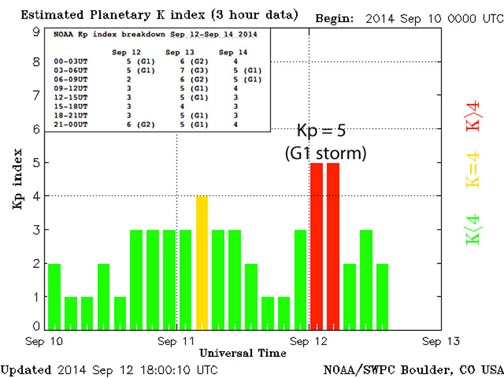
Source: NOAA
Now that you're subscribed, you will need to familiarize yourself with two key concepts: the Kp index and Bz. Every report includes a reference to them. The index, from the German planetarische Kennziffer or "planetary code number", indicates the severity of Sun-induced magnetic disturbances in Earth's vicinity. Rated on a scale from 0 to 9, it's compiled using magnetometers at 13 magnetic observatories around the globe and updated every 3 hours.
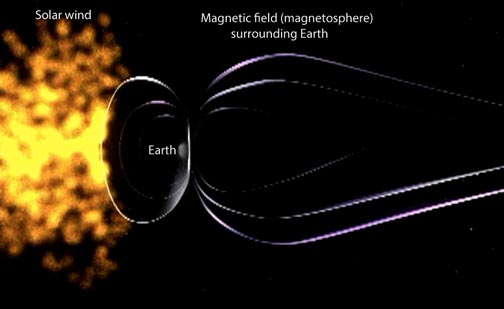
NASA
When the index is below 5 the chances of seeing aurora are low or nil. A Kp of 5 likely indicates a minor or G1 geomagnetic storm visible across southern Canada and the northern U.S. When the index hits 6 or 7, auroras intensify as the auroral oval spreads southward. Skywatchers across the middle U.S. then get a shot at seeing shimmering curtains of pink and green light dance across their normally aurora-free skies.
Every forecast that arrives in your e-mail includes the estimated Kp index. A quick glance is all it takes to see if any "fives" are on the way. "Sevens" indicate an intense storm.
Ready to move on to Bz? Embedded within the billowy clouds of solar plasma is the stamp of the Sun's magnetic field. Like a magnet, the swarm has regions of positive and negative polarity.
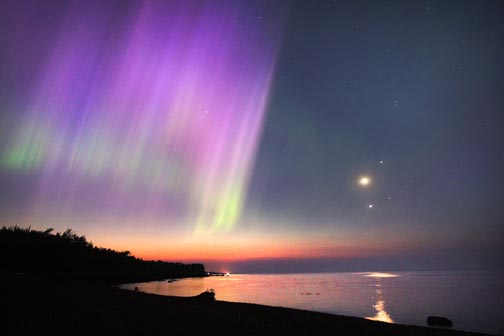
Bob King
Most of the time, Earth's protective magnetic bubble deflects the disturbance and we're none the worse for wear. But if the south-pointing region of the cloud (said to have a southward or negative Bz) happens to brush against Earth's northward-pointing magnetic field, the two will link up like two magnets snapping together. A path now opens for electrons and protons to spiral down Earth's magnetic field lines and smack into atoms and molecules in the upper atmosphere above the polar regions. The atoms reach an excited state and then return to relaxing and smoking cigars by releasing photons of green and red light. This is what creates the aurora.
Wouldn't it be nice to know in advance if an incoming blast possessed a south-pointing (Bz)? Wish granted!
Since 1997, we've been getting help from NASA's Advanced Composition Explorer (ACE) which orbits at the L1 libration point, one of five places near Earth where the Sun’s and Earth’s gravity are in balance, allowing a satellite placed there to remain relatively stationary.
ACE acts as a distant early warning station 932,000 miles (1.5 million km) from Earth in the direction of the Sun.The probe detects the direction, strength and magnetic field particulars of incoming blasts of particles from the Sun and provides about an hour's advance warning of dangerous storms.

NASA
All this rich information, including the direction of the Bz, is plotted in near real time (updates every few minutes) at the ACE Dynamic Plots site. You can choose to see the Bz ups and downs at intervals from 2 hours to 7 days. Choose an interval and then click the "MAG SWEPAM" link.
The top plot, shown as a squiggly red line, represents the Bz. When it's positive or above the midline, the incoming solar wind points north and is unlikely to connect with Earth's field. But when it dips below the line, and in particular, when it sinks to –10 or lower, auroras are in the offing.
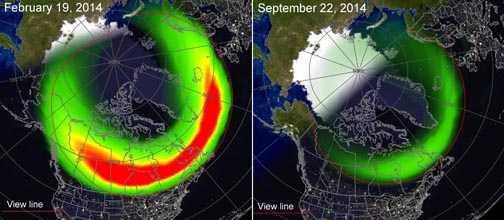
NOAA
One final tool I'm sure you'll find useful is a relatively new NOAA product called the Ovation Oval. Simply, it shows the extent of the auroral oval, the permanent caps of aurora centered on Earth's geomagnetic poles. Polar bears and other arctic residents get to experience auroras most dark nights of the year. The rest of us have to wait for more vigorous storms, when the oval expands southward to more populous latitudes.
I hope this little guide will help you in your planning. I've selected just a few of all the resources available on the Web — you will undoubtedly find more. However you plan, remember that space weather can often be as unpredictable as Earth weather. Happy forecasting!
Learn about the science of aurora in our recent cover story.
 2
2









Comments
Frank Reed
September 25, 2014 at 3:07 pm
Something that confused me for years about the auroral ovals is that they're not centered on the magnetic poles (as usually defined) . For example, the north "magnetic pole" --the location north of Canada where a compass needle points vertically-- has been rapidly moving towards Siberia in the past couple of decades, and it's towards the margin of the auroral oval in the maps today. But the less frequently defined "geomagnetic pole" is a better match for the large-scale features of the Earth's magnetic field, and apparently the auroral ovals are usually more or less centered on the north and south geomagnetic poles "usually displaced slightly to the night-side of the geomagnetic poles". Here's a nice article with maps showing the locations of these two types of magnetic poles:
http://www.geomag.bgs.ac.uk/education/poles.html
The "geomagnetic poles" are antipodal by definition, and this feature also matches the rough symmetry between the north and south auroral ovals. By contrast, the "magnetic poles" (defined by a vertical compass needle) are a long way from being antipodal. Note that Bob King's article here has this right --he refers to the "geomagnetic pole".
You must be logged in to post a comment.
September 26, 2014 at 12:17 pm
Our new documentary gives you all you need to know about the Northern lights including photo tips. Here is the trailer.
https://vimeo.com/87472898
You must be logged in to post a comment.
You must be logged in to post a comment.